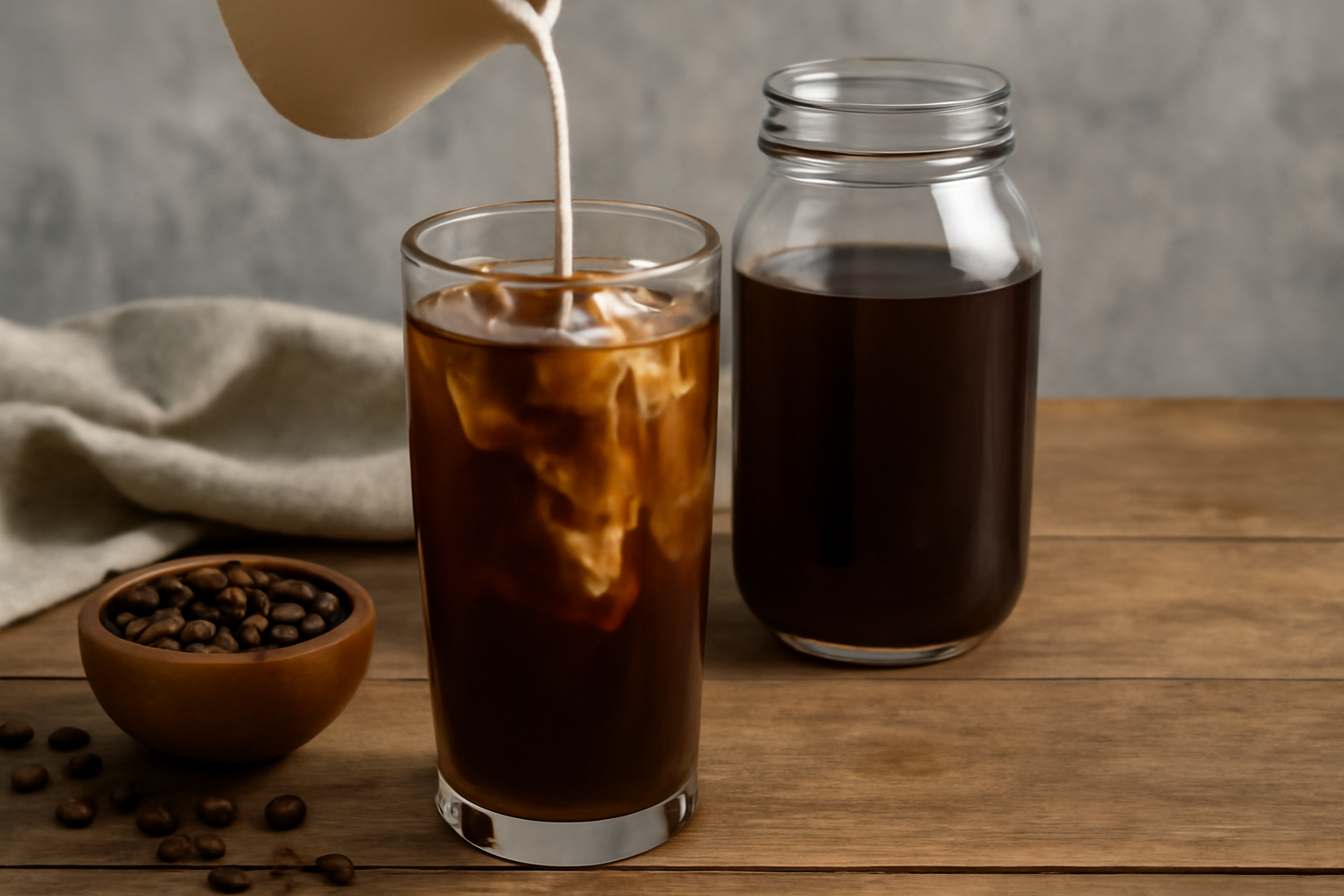Cold brew coffee has gained immense popularity in recent years, particularly during the warmer months. It’s a smooth, refreshing, and less acidic alternative to traditional hot coffee, and it can be enjoyed on its own or used as a base for iced lattes, milkshakes, and other coffee beverages. If you’re tired of your regular cup of coffee and want to explore something new, making your own cold brew coffee is easier than you think. In this guide, we’ll take you through the steps to make the best cold brew coffee at home, from selecting the right beans to the brewing process and serving tips.
1. What is Cold Brew Coffee?
Cold brew coffee is made by steeping coarsely ground coffee beans in cold water for an extended period, typically 12 to 24 hours. Unlike iced coffee, which is brewed hot and then chilled, cold brew coffee is brewed at a low temperature, resulting in a smoother, sweeter, and less acidic flavor. Because of the extended steeping process, cold brew coffee tends to have a higher caffeine concentration compared to traditional brewed coffee, making it a strong and energizing drink.
Why Cold Brew?
- Smooth Flavor: Cold brew is known for its smooth and mellow flavor. The long steeping process extracts fewer bitter compounds, resulting in a coffee that is sweeter and less acidic.
- Convenience: Once brewed, cold brew concentrate can be stored in the fridge for up to two weeks, so it’s perfect for those who want to have a ready-to-drink coffee without the daily effort.
- Versatility: Cold brew can be served black, with milk, or flavored with syrups and spices, offering endless possibilities for customization.
2. Choosing the Right Coffee Beans for Cold Brew
The first step in making great cold brew coffee is selecting the right beans. While any coffee beans can be used for cold brew, some beans are better suited for the low-temperature brewing process.
Best Coffee Beans for Cold Brew
- Coarse Grind: For cold brew, the grind size is important. You’ll need a coarse grind, similar to sea salt. A finer grind will make the coffee too strong and gritty, while a coarser grind ensures smooth extraction and a clean taste.
- Single-Origin vs. Blend: Single-origin beans are a great option if you want to explore different flavors, as they showcase the unique characteristics of the region they come from. However, many people prefer espresso or medium-dark blends for cold brew because they offer a balanced flavor that stands up well in the cold brew process.
- Flavor Profile: Cold brew coffee tends to highlight the smoother, sweeter notes of the beans, so it’s best to select beans with flavors that complement this profile. Beans with chocolatey, nutty, and caramel notes work particularly well.
Popular Coffee Bean Types for Cold Brew
- Ethiopian Beans: Known for their bright and fruity flavors, Ethiopian beans can add complexity to your cold brew while maintaining a smooth, refreshing taste.
- Brazilian Beans: Brazilian beans are often sweet, nutty, and chocolatey, making them a great choice for cold brew coffee.
- Sumatran Beans: Sumatran beans tend to have earthy, full-bodied flavors, which can lend richness to your cold brew.
3. The Cold Brew Brewing Process
Making cold brew coffee is as simple as mixing ground coffee with cold water and letting it steep. The process itself is straightforward, but the key to getting a great cup lies in the ratio of coffee to water, the steeping time, and how you filter the coffee.
The Ratio of Coffee to Water
The coffee-to-water ratio is one of the most important factors in brewing cold brew. Too much coffee can make the cold brew overly strong, while too little can result in a weak, watered-down brew.
- Standard Ratio: A typical cold brew ratio is 1:4 (1 part coffee to 4 parts water) for a concentrate. This makes the coffee strong, and you can dilute it with water, milk, or ice when serving.
- Lighter Brew: If you prefer a less concentrated brew, you can use a 1:5 or 1:6 ratio. This will result in a milder cold brew that’s easier to drink straight without much dilution.
Brewing Method
- Measure and Grind: Start by measuring your coffee beans. For a 1:4 ratio, use 1 cup (about 85 grams) of coarsely ground coffee to 4 cups (950 milliliters) of cold or room-temperature water.
- Mix the Coffee and Water: In a large jar or pitcher, add the coarsely ground coffee and water. Stir the mixture to ensure the coffee grounds are fully saturated.
- Let It Steep: Cover the jar or pitcher and let it steep at room temperature or in the refrigerator for 12 to 24 hours. The longer you steep, the more concentrated and flavorful the brew will be. Experiment to find the steeping time that works best for your taste.
- Stir Occasionally: If possible, stir the mixture once or twice during the steeping process to help the grounds fully mix with the water. This ensures even extraction and a smoother flavor.
- Strain the Coffee: After the steeping time is up, it’s time to filter the coffee. Use a fine-mesh strainer, cheesecloth, or a coffee filter to strain out the coffee grounds. If you use a strainer, it’s a good idea to double-filter the coffee to remove any remaining fine grounds.
Serving Your Cold Brew
Once filtered, you’ll have a concentrated cold brew coffee. You can store this concentrate in an airtight container in the fridge for up to two weeks. When serving, you can dilute the concentrate with water, milk, or your preferred non-dairy alternative. For a refreshing touch, serve it over ice with a splash of milk or a flavored syrup.
4. Tips for Perfect Cold Brew Coffee
- Freshness Matters: Always use fresh coffee beans for cold brew. Beans that are stale or pre-ground may result in a flat and less flavorful brew.
- Use Filtered Water: If possible, use filtered water, as tap water with high mineral content can negatively affect the taste of the coffee.
- Experiment with Steeping Time: While 12-24 hours is the standard, you can adjust the steeping time based on your preferences. A shorter steeping time will result in a lighter brew, while a longer steeping time will create a more robust, flavorful concentrate.
- Dilution is Key: If your cold brew concentrate is too strong, you can always dilute it with water or milk. Some people prefer to dilute their cold brew with equal parts milk for a creamier texture.
- Flavor Variations: Cold brew is highly customizable. You can add flavorings such as vanilla, cinnamon, or even chocolate to your cold brew while it steeps for a unique twist.
5. Cold Brew Coffee Variations
While classic cold brew is delicious on its own, you can experiment with different flavors and variations to create a more personalized coffee experience. Here are a few ideas:
- Vanilla Cold Brew: Add a few vanilla beans or a dash of vanilla extract to your cold brew concentrate while it steeps. The vanilla adds a subtle sweetness and warmth to the coffee.
- Cinnamon Cold Brew: For a spicy kick, add a cinnamon stick or ground cinnamon to your cold brew as it steeps. This pairs beautifully with the rich, smooth flavors of the coffee.
- Mocha Cold Brew: Add chocolate syrup or cocoa powder to your cold brew for a decadent, mocha-inspired drink. You can also blend it with milk for a cold mocha latte.
- Cold Brew with Cream: For a creamy, indulgent treat, add a splash of heavy cream or sweetened condensed milk to your cold brew concentrate. This transforms it into a rich, dessert-like beverage.
6. Iced Cold Brew Lattes and More
Cold brew coffee also serves as the perfect base for a variety of iced coffee drinks, including iced lattes, iced coffee tonics, and iced macchiatos.
- Iced Cold Brew Latte: To make a cold brew latte, combine cold brew concentrate with milk or a milk alternative (such as oat milk) and ice. The milk balances out the strong flavor of the cold brew, resulting in a creamy and smooth beverage.
- Iced Coffee Tonic: For a refreshing twist, mix cold brew coffee with tonic water and ice. The effervescence of the tonic water adds a unique fizz to your cold brew, making it a perfect drink for a hot day.
- Iced Cold Brew Macchiato: For a layered iced drink, pour cold brew concentrate over ice and add a small amount of milk to create a macchiato-like drink. The milk should be added last to form a layered effect.
Conclusion
Cold brew coffee is the perfect way to enjoy coffee in a refreshing, smooth, and less acidic form. By following the right brewing process, using the best coffee beans, and experimenting with flavor variations, you can create a cold brew coffee that suits your personal taste. Whether you enjoy it black, with milk, or in various iced coffee drinks, cold brew is a versatile and easy-to-make coffee beverage that’s perfect for any time of year.

I’m an economist with 15 years of experience in strategic planning and a lifelong passion for wellness and natural living. As a self-learner, I created Herbalife Balance to share insights on healthy eating, mindful habits, and an active lifestyle. Tennis enthusiast and nature lover, I believe in balance as a path to well-being. Through this blog, I help others live healthier, more conscious lives.

